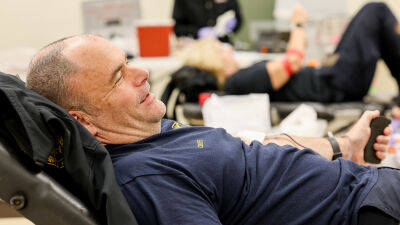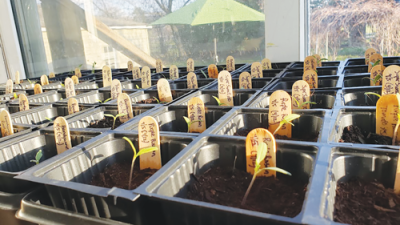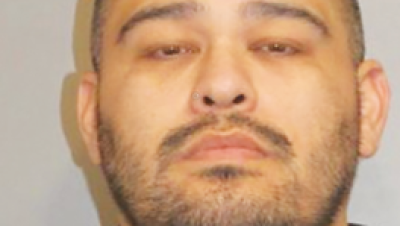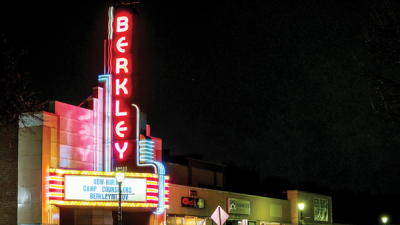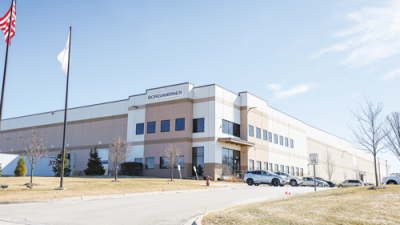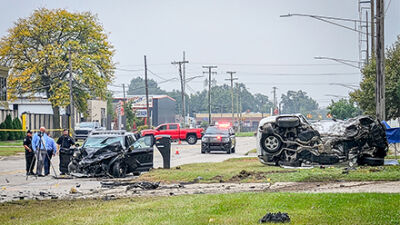
Macomb Intermediate School District Superintendent Michael DeVault talks about teacher salaries during the tour.
Photo by Patricia O’Blenes
EASTPOINTE — As chairman of the Michigan Senate Pre-K-12 Appropriations Subcommittee, Sen. Darrin Camilleri, D-Trenton, has been visiting school districts around the state to determine their individual needs.
On April 7, the state official toured Eastpointe High School to discuss the status of the district, including finances, infrastructure and academics.
For about an hour, Camilleri, a former teacher, met with Eastpointe Community Schools Superintendent Christina Gibson; state Sen. Veronica Klinefelt, D-Eastpointe; Macomb Intermediate School District Superintendent Michael DeVault; and Eastpointe Community Schools Board of Education President Jon Gruenberg. Also present were Christopher Ford, constituent relations for Klinefelt’s office, and Jonathan Mason, deputy chief of staff for Camilleri.
“Some of the things you are talking about are things I want to tackle,” Camilleri said. “Over the next month or two, we’ll be introducing our proposals to really fix some of these problems.”
The group walked around the school with the auditorium as one of the first stops. Gibson said the district’s last bond issue provided funding for some upgrades in the auditorium, but lights and sound upgrades are needed. The school officials discussed the large size of the high school, which was built in 1929 and also had a building addition during its history.
“Can the district keep a school this size going? My concern is, and I know there is a lot of hesitation because of the historic nature and the alumni, if they need a newer school that’s smaller, that isn’t eating up so much energy,” Klinefelt said. “Jon, I think feels if we can get the needed repairs, that we can sustain the school.
“I do think that’s a conversation for them to have internally; it’s not our business. But if they ever reached a point where they couldn’t sustain this, they can’t build a new school without help,” she told Camilleri. “I just wanted it on your mind because you’re going to be the chair of that for several years.”
“Our elementaries are in a great place,” Gibson said, but decisions about Eastpointe High School could be on the horizon. “Do we keep it? Is it viable? Do we make a community center? These are big, huge, crazy, wild decisions to make that have long-term implications.”
“We have a larger physical footprint in the community than we would need as a district, if you look at the space we have and the number of students we have,” Gruenberg said. “Is there a way we can get it classified as a historical building and possibly get some grants or funding from the state? That can do some of the repairs and we can do some.”
Klinefelt questioned what would happen to Eastpointe High School if the decision is made to build a new, more modern high school.
“What do you do with this?” she asked.
“It should find some purpose,” Camilleri said. “It’s not a building that is in total disrepair that you have to get rid of.”
The group also made a stop at the high school pool, which has not been in use for over a year and needs about $400,000 worth of repairs. When in the cafeteria, the discussion turned to employee health care benefits and salaries. Gibson said the starting salary for a teacher is $45,000.
“The starting pay should be somewhere around $60,000,” DeVault said. “I know we’re not going to get there, but that should be the goal.”
“We really need the higher-paid teacher teaching here. Just the caliber of people we need to do this work,” Gibson said, adding, “Special education teachers are very hard to come by.”
Camilleri added that educators do expect a degree of financial security.
“The intent I think was that, if you knew you were going to be an educator, you weren’t going to be rich, but you could have a couple pieces of stability, retirement and health care,” Camilleri, 31, said. “You knew you would have those things at the end of your career and you would be OK. You knew it was something that would help your family.
“People who are my age are leaving the profession after five, 10 years, even fewer, deciding I can leave, I don’t have a pension, I don’t have this health care component,” Camilleri said. “I can go get any other job and use these intense skills that you get as an educator and make double the pay.”
Gruenberg brought up teachers having to pay 20% or a flat fee for medical insurance.
“If we’re going to prioritize teaching and we’re going to prioritize education, why wouldn’t we make that profession look a little more appealing than some of the others in the private sector,” Gruenberg said. “You can see there is a decline in a number of students that are actually going into the profession.”
The group also talked about schools of choice.
“Once (a district) started getting kids from other districts, their kids started leaving. You watched it go district by district by district, going east, going north. It’s a tear down of the communities,” Klinefelt said.
“The biggest problem with schools of choice, once the community is torn down, parents aren’t showing up to PTO meetings,” Klinefelt said. “They’re no longer volunteering at the local festivals. There is no connection to each other. It has an unbelievable impact on a community. That’s one of the things we’re fighting, because it’s that sense of community that makes kids successful.”
 Publication select ▼
Publication select ▼
